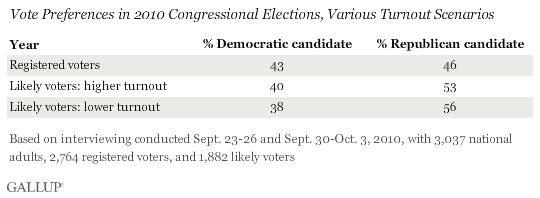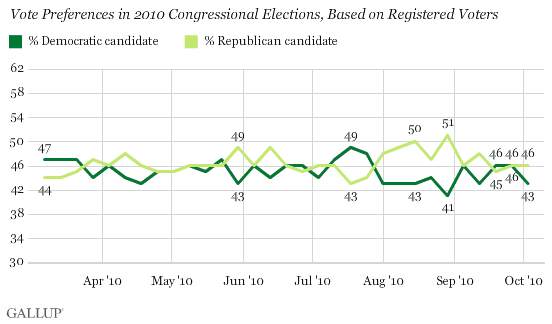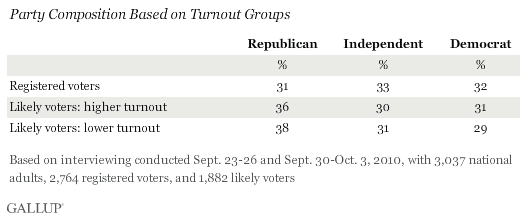PRINCETON, NJ -- Gallup's generic ballot for Congress among registered voters currently shows Republicans with 46% of the vote and Democrats with 43%, similar to the 46% to 46% tie reported a week ago. However, in Gallup's first estimates among likely voters, based on polling from Sept. 23-Oct. 3, Republicans have a double-digit advantage under two separate turnout scenarios.

These initial estimates are based on interviews with more than 3,000 national adults, including more than 2,700 registered voters, and more than 1,800 adults who demonstrate a high probability of voting this fall, based on their answers to Gallup's standard likely voter questions that probe current voting intentions and past voting behavior.
Among registered voters interviewed over this period, the parties continue to have rough parity on Gallup's generic ballot for Congress, as they have since early September. If all voters turned out at this point, the national vote would be close, with Republicans having the slight edge.

However, not all voters will turn out. For this reason, Gallup identifies the subsample of registered voters most likely to vote in November, employing methods first used in the 1950 midterm elections. These estimates are based on respondents' answers to seven separate turnout questions. The results are used to assign a "likelihood to vote" score to each registered voter and, in turn, to create hypothetical models of the electorate based on various turnout scenarios.
For this initial estimate of those most likely to vote, Gallup has modeled a lower turnout estimate (40%, typical for recent midterm elections) and a higher turnout estimate. In both cases, the Republican share of the vote is above 50% and the Democratic share is 40% or less, underscoring the strong position in which the GOP would find itself were the election held today.
Gallup has found Republicans, compared with Democrats, expressing higher levels of enthusiasm about voting and more thought given to the elections throughout 2010. It follows that models in which voting is restricted to those most likely to vote would show Republicans doing disproportionately well.
Gallup's historical election trends suggest that the race often tightens in the final month of the campaign. In September and October 1994, 2002, and 2006, Gallup's likely voter estimates showed larger margins for the leading party than what the final estimate showed (with the final poll in 2002 moving from a slight Democratic advantage to a Republican lead in the final poll). At this point, four weeks remain until Election Day, and given the already-high levels of Republican enthusiasm, it is possible that Democrats could have relatively greater gains among likely voters over the next month. This history suggests that the likely voter model results at this point should be viewed as describing the current state of affairs, but not as predictive of the final party vote shares on Nov. 2.
Within both likely voter pools, Republicans are highly likely to vote for the Republican candidate, and Democrats for the Democratic candidate. Independents in both likely voter models skew strongly toward the Republican candidate. Gallup has found independent registered voters consistently preferring Republican candidates throughout the campaign.
Across both turnout scenarios, the overall vote results reflect the fact that Republicans become a larger part of the sample as turnout shrinks.

Based on statistical modeling of the historical relationship between the national vote and seats, any situation in which the Democrats have less than about 47% of the actual two-party national vote for Congress (i.e., 53% voting for the Republicans and 47% for the Democrats among those voting for one of the two parties) would strongly predict that Republicans would win enough seats to gain control of the U.S. House of Representatives. If there is a widely disproportionate skew in turnout toward Republican voters and their national vote lead ends up being in the double digits, the Republican gains would be very substantial.
Gallup will continue to update both trends in registered-voter voting intentions and the hypothetical results of various likely voter models between now and Election Day. Gallup's final likely voter estimates have historically been very close to the final national vote.
Learn more about Gallup's likely voter models for the 2010 midterm congressional elections.
Results for this Gallup poll are based on telephone interviews conducted Sept. 23-26 and Sept. 30-Oct. 3, 2010, with a random sample of 3,037 national adults, aged 18 and older, living in the continental U.S., selected using random-digit-dial sampling.
For results based on the total sample of national adults, one can say with 95% confidence that the maximum margin of sampling error is ±2 percentage points.
For results based on the total sample of 2,764 registered voters, one can say with 95% confidence that the maximum margin of sampling error is ±2 percentage points.
For results based on the total sample of 1,882 likely voters, the maximum margin of sampling error is ±3 percentage points.
Interviews are conducted with respondents on landline telephones (for respondents with a landline telephone) and cellular phones (for respondents who are cell phone-only). Each sample includes a minimum quota of 150 cell phone-only respondents and 850 landline respondents per 1,000 respondents, with additional minimum quotas among landline respondents for gender within region. Landline respondents are chosen at random within each household on the basis of which member had the most recent birthday.
Samples are weighted by gender, age, race, education, region, and phone lines. Demographic weighting targets are based on the March 2009 Current Population Survey figures for the aged 18 and older non-institutionalized population living in continental U.S. telephone households. All reported margins of sampling error include the computed design effects for weighting and sample design.
In addition to sampling error, question wording and practical difficulties in conducting surveys can introduce error or bias into the findings of public opinion polls.
For more details on Gallup's polling methodology, visit https://www.gallup.com/.
